Winter Bow Hunt Photos Part 2



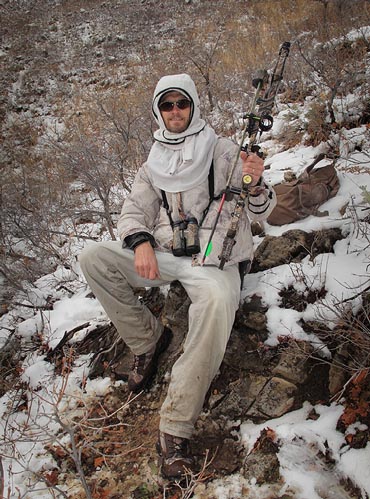






The following photos are from my Utah extended archery hunt in October and November. The hunt ended on November 30 and I did not shoot a deer.
As a trophy hunter, I was holding out for real record-class buck. Also, my wife already shot a huge bull elk, so meat wasn’t a big concern, rather I was mostly looking for a challenge. All told, I could have shot close to 30 bucks, the most buck encounters I’ve ever had. Of those bucks, half were young two- and three-point bucks, and the rest were either too small or too smart. It was a challenge indeed!

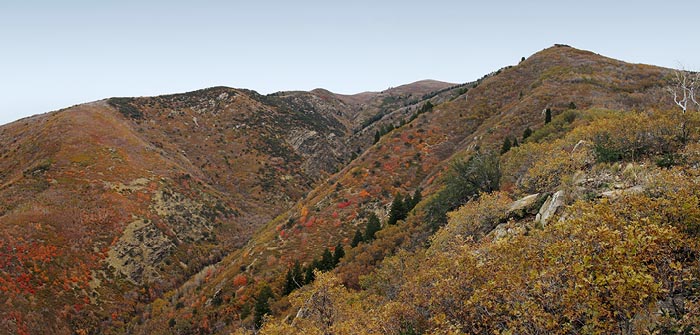

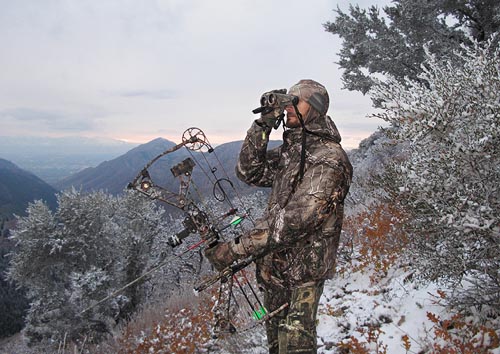
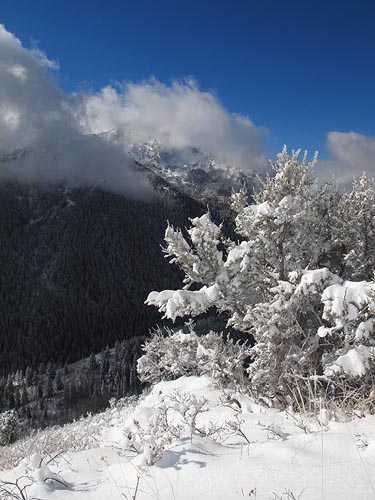
Hello Zen-bowhunter blog readers. Today marks my 100th blog post. A year and a half in the making, my little archery/hunting blog is still going strong thanks to you, my loyal readers. My sincere hope is that everyone has enjoyed at least some of my content. I truly believe there’s something here for everyone, not just hunters.
One of my greatest passions in life is seeking self-improvement through archery. Archery is an individual sport, which means each person learns and grows at his own pace. There is no competition or pressure to succeed, except from yourself. Most people find archery (and bowhunting) to be a wonderful, meditative way to achieve clarity and peace and even Zen. After all, Zen-through-archery has been taught in Japan for a thousand years. My goal in this blog is to help you succeed in both Zen-archery and in life. Once a person achieves Zen, he realizes he can do anything he puts his mind to.
On a personal note, we are entering the peak of the mule deer rut in Utah. This means the biggest bucks will be climbing down from the high country to participate in their annual mating ritual. For those of you that still have an unused archery tag, it’s going to be an exciting (and COLD) month. Maybe I’ll see you in the hills.
Best of luck in your own endeavors, and may the Zen-force be with you!
 Scent Control vs. Scent Reduction
Scent Control vs. Scent ReductionUnderstanding how to control or reduce human scent is key to success in bowhunting. Unlike humans, with our flat faces with cute little noses, the deer’s entire face and head is built around one gigantic nose and several inches of nasal passageway. Deer use their nose continually to survive, first by detecting danger at far distances, second to sniff out food, and third to sniff out a mate. But don’t despair. The fact that deer have such amazing sense of smell is the only reason they even still exist at all here in the future. As hunters we should admire its prowess and design. We want deer to survive…so that we can hunt them!
Human scent—or odor—is managed in three different ways: Scent masking, scent reduction, and scent control. Scent masking means using other scents—such as deer urine, pine extract, or sage—to cover up human odor. I rarely use scent masking so I’ll leave it out of this article. Instead let’s look at scent control verses scent reduction.
First off, total scent control—aka “scent elimination”—is really impossible. No matter what measures you take to eliminate human scent, you’ll still ooze some amount of odor, especially after a few days living in the woods. The only fool-proof way to control human scent is by using the wind to carry your scent away from your intended quarry. After 25 years in the field I’ve come to realize that scent control is impossible by any means other than wind. But winds can and do change direction. Therefore, 100% scent control is still impossible. That being said, I’m a firm believer in scent reduction.
Scent reduction means using commercial chemical or enzymatic odor neutralizing sprays, soaps, wipes, and special clothing to neutralize odor on your body and gear. In my experience scent reduction efforts are only marginally effective, but it does give me a little peace of mind.

For many years I’ve washed my clothes and body in scent masking soap before each hunt, and then used scent neutralizing spray at camp. Yet I am continually amazed at deer’s ability to pick me off no matter what precautions I use. When the wind is bad, it’s over, plain and simple. Your slightest human scent can blow out an entire canyon before you even step foot in it. Although I can’t completely eliminate my scent, I know that a reduced scent won’t travel as far, and if the wind changes momentarily, perhaps it will be diluted enough to go unnoticed, allowing me edge a little closer to the buck.
One reason we have such a hard time eliminating odor is because of the tremendous amount of gear we carry into the field that hasn’t been adequately washed down with scent control products. I recently began taking inventory of some of these items:
• Wrist watch
• Belt
• Boot insoles/lining
• Gum
• Every single content of your backpack
• Wallet/keys
• Chapstick
• Water bottle
• Food/snacks
• Phone/GPS
• Binoculars and harness
• Rangefinder and case
• Bow
• Armguard/Release aid
• Sweat/skin/hands/pores
• Hair
• Mouth/Breath/Lungs
Did I miss anything? Probably. Now let’s look closer at some of these items:
Mouth: To keep my mouth from running afoul, I chew gum in the field. But I don’t brush my teeth in the field, and I’m always breathing. Does the inside of your lungs have an odor? Not to you, but probably to the deer. Just by breathing you are continually announcing your presence to the woods.
Boots: No matter how much scent masking spray you use on your boots, the boots still breathe with each step. Go ahead and stick your face in your boot. Do you smell your sweaty insoles? Does the lining or the leather have an odor? Probably. And the deer can smell it too.
Skin: Your skin has pores which seep sweat and oil continuously. Even if you wash your hands before going afield, an hour or so later they’ll be dirty again. And a few hours after that, they are grimy and stinky. Fortunately, several companies sell special scent wipes for field use, but I don’t use them. I have enough junk in my pack already, and even then, your hair is continually accumulating oil and dirt just by sitting there.
You get the idea.
So, what can you do? Don’t obsess over scent control. Trust me; you’ll go nuts trying to mask everything. Really, how fun is it to spend hours washing and wiping down your Chapstick, keys, binos, arrows, wallet, etc?! The deer will still sniff out something else.
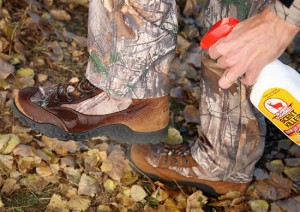
Since pure scent elimination is really impossible, efforts to reduce scent are two-fold: First, keep the wind in your face and plan your stalks according to wind direction whenever possible. Second, use commercial scent masking products such soaps, deodorizers, and sprays. Go ahead and use whatever magical scent masking product you wish, but don’t count on it to save the day. My advice is to spare your obsession with scent control and focus on hunting skills instead.
In reviewing my last few stories I realized that the common thread was luck; both good and bad luck. Luck vs. skill is a constant struggle in hunting, so today I’ve written some of my ideas concerning luck:
Never let someone tell you that hunting is all skill and no luck, even me. It seems that all I write about is acquiring the innumerable skills necessary to be successful in bowhunting, but rarely do I speak of luck.
Today I’m speaking strictly of luck.
I had kind of a push-pull type of conversation with a friend not too long ago. He said that hunting had a whole lot to do with luck, which was something he generally lacked. Taken a bit back, I retorted that hunting also has a whole lot to do with skill. He replied, “Yes, but luck is definitely a factor.” I replied, “Yes, it’s true; you have to have some luck on your side, but you need skills too; it’s not a 50/50 split. I’d say it’s closer to 80/20; Sure, a guy is will occasionally stumble into a big buck, but without some decent skills he won’t be consistent from year to year.” We left it at that.
I’m sure you’ve heard all the motivational sayings, such as Stephen Leacock’s, “I am a great believer in luck, and I find the harder I work the more I have of it.” Or Emerson, “Shallow men believe in luck. Strong men believe in cause and effect.” These adages imply that there is no luck, just hard work. But hunting is a little different. Hard work doesn’t necessarily guarantee you anything.
First off, you need to remember that there are two kinds of luck: good luck and bad luck. In hunting, there is a lot more bad luck than good luck. This is because of the innumerable variables that are beyond your control in nature. As a result, bowhunting success is generally less than 25%. Therefore a bowhunter must acquire great skills in order to swing the odds in his favor. Occasionally a person will luck into a big buck, but more often than not he’ll luck out.
My primary motivation for this article is reflecting on yet another difficult hunting year and a failed deer hunt. Certainly I had some great opportunities–due mostly to experience and skill–but in the end it was sheer, uncontrollable bad luck that accounted most for my failure. Here’s just one example:
It was just another super-hot, super-dry day in the woods. I quickly realized that still-hunting was a terrible approach because the ground was so dry and loud. Worst of all, the drought-like conditions seemed to irritate the squirrels more than usual. The squirrels are always bad, but the hotter it gets, the more cantankerous they become…just a theory. Anyhoo, I was traveling from one bedding area to another. For once the wind was blowing hard and constant in my face, so I really didn’t have to be quiet. However, the squirrels were ferocious. As soon as I left one squirrel, another would fire up ahead of me. Their constant barking was driving me nuts! It didn’t really matter though, since there were so few deer in the area. I was hunting my 5th choice unit after all, thanks to the living nightmare of not being able to draw a decent tag in my own state, which is quickly becoming a dreary reality, but I digress… So, I was approaching a known bedding area with little hope. A squirrel fired up as soon as I entered the woods, and I thought nothing of it. As I rounded a pine tree, my eyes latched onto a pair of big, floppy ears rotating in the woods. I froze. In the dense tangle sat a big, heavy-horned 4×4, 170-class buck bedded facing away from me at only 30 yards. My dream was about to become a reality! But as I slowly reached for an arrow, another squirrel up ahead suddenly lit up into a full nutty rage. The smart old buck stood instantly and walked into the woods. He paused for a second to look back, then disappeared out of my life forever. Needless to say, I was enraged. I vowed that next year I would go into the woods two weeks before the hunt and kill every single squirrel on the mountain.
It’s easy to blame bad luck for failure, the same way that it’s easy to blame great skills for success. The trap you don’t want to fall into is relying on sheer luck, good or bad. Blaming a bad hunt on bad luck is an excuse to stop trying. Same with blaming success on good luck.
If you had an unlucky year like I did, you must remember that luck changes often. It’s like in poker: some nights you can’t get any cards, and other nights you can’t lose. In hunting you might go five years without bagging a buck, and then suddenly you bag one every year. The point is to never give up.
Today I believe success in hunting is an 80/20 split. An 80/20 split means that you’ll be successful 4 out of 5 years because you’ve acquired the necessary skills. The one year that you fail, you can go ahead and blame on bad luck. With great skills it doesn’t matter how much bad luck you have because when your luck changes, you are going find wonderful and consistent success!
I didn’t shoot the photo above; I borrowed it from the Utah DWR. However, it perfectly captures what goes on in my mind 25 hours a day, 8 days a week, 366 days a year.
The Utah archery deer hunt opens this Saturday! From there I’ll have 4 weeks to accomplish the one thing I live for: harvesting a trophy buck with my bow. In this article I’m goint to talk about goals and priorities and how they relate to hunting and life.
Each bowhunt I go through the same process: A grand, ritualistic prehunt meditation that consumes my being. My mind is being reformatted. Time expands to include the present, past and future simultaneously. As I sit here typing, I’m already in the woods. For the last couple weeks I have become useless in every facet of my life. My soul is set upon a nearly impossible goal that consumes every minute of the day. My phone rings, people talk, and I walk around, but it is all background noise. I can’t focus on anything but the glorious task ahead of me.
As the hunt nears, I also become overly hopeful. Last year my goal was to shoot my third 200+ inch deer in five years. I hunted harder and put more days in than ever before, and I didn’t even see a 200″ deer. The biggest was maybe 180″.
Half-way through the season I started to realize that any big four-point was the best a bowhunter could hope for these days, mainly because there just aren’t that many big bucks left. Thanks to greater and greater human expansion into Utah’s winter range–not to mention a whole new onslaught of statewide poaching and highway casualties–fewer and fewer bucks live to maturity. So the odds of success are always declining. Does this mean I should set the bar lower? Maybe; I’ll wait for that deer to step out and then decide.
Being a professional photographer, archery instructor, taxidermist, and writer has made this the busiest year of my life. I worked every single day in July, mostly out in the hot sun, sometimes ten hours without a break. As busy-ness began winding down, I was discussing work with an associate of mine. He remarked, “Hey, at least the money is good, right?” I said, “You know, the only reason I work so hard is so I can take the entire hunt off work if necessary. Bowhunting is all I care about. Every single thing I do–the whole reason I even get out of bed in the morning–is so I can hunt. Everything else is secondary. When my wife asked me to marry her, I tried to warn her, but she married me anyway (ha-ha). I know my purpose in life…”
There’s a saying: People enjoy what they’re good at (and despise what they suck at.) A couple years ago I had an epiphany: I’m good at lots of things (archery, photography, music, taxidermy, etc.), but I’m great at only one thing: Bowhunting. I didn’t choose it; it chose me.
Not too many years ago I stunk at hunting, so I only committed to hunting three or four days a year. Now I commit several weeks, mostly because I know that quality bucks take a lot of time, skill, and yes, even luck. And the best way to be successful and lucky is to be in the field, not at home, not at work, not golfing, etc. I set a very lofty goal, then do whatever it takes to achieve it.
I also know a whole lot of very unsuccessful hunters, some whom are close family and friends. Most of them say that I’m lucky and they’re not. Maybe they’re right, but I’ll tell you right now: while I’m alone in the woods from Tuesday through Friday, or trudging five miles up some frozen canyon in three feet of snow, those people are sitting at work or in front of the television, waiting for me to get lucky. And then I stumble into some unsuspecting giant…
Long story short, trophy hunting isn’t for everyone. Most hunters would be happy with any deer, or at least some sort of consistency from year to year. But it’s hard to achieve even moderate success when we put so many other priorities ahead of hunting.
I believe everyone get’s ONE THING; one big thing that you’re great at. That’s the great mystery of life; finding that one thing! Unless that “one thing” is hunting, don’t expect a trophy deer too, because in the deer woods it’s all or nothing. You either commit 100% to the task loooooong before the season opener, or you’ll likely fail. The season blows in and out, haphazardly.
This blog is about one thing: Successful trophy bowhunting. I truly believe that success in hunting is a decision, and anyone who sets their priorities in that direction will accomplish it year after year.
When I was just starting out as a photographer, I made a conscious effort to learn only from the greatest photographers and study only their methods. There were tons of “good” photographers out there, but great photography can only be learned from the greats. The same idea applies to hunters.
I don’t know that I am a great hunter. But I do believe in the methods I’ve developed and follow. I also believe that the greatest teacher is the woods itself. I know there is a natural law and how to follow it. I know how a mountain lion hunts and survives by successfully taking a deer every ten days or so all year-round. Lions are the “greats” of the hunting world.
Lastly, I believe that the road map to success is fully integrated into the text of this blog and my book, Zen Hunting. I don’t think I’ve left anything out, but I will keep trying to help.
Good luck this year!
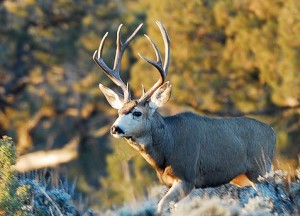
Has anyone ever told you, “Deer are where you find them?”
Maybe it’s a Utah thing, but I’ve heard that:
While scouting last weekend I found a group of big, blocky buck tracks in an unassuming area. Why were the bucks here?, I wondered. Were they moving from bed to feed, or vice-versa? Were they just migrating through? Was there low spot on the mountain that funneled them through here? I’m not sure, but I have my theories. If I can figure out why, then maybe I can intercept them during the hunt.
What does this have to do with hunting? Because wherever a deer is, he has a good reason for being there. Deer don’t take vacations, they don’t explore randomly, and they never wander aimlessly. If a deer is moving, he’s moving for a reason. Maybe he’s coming from feed or bed; maybe he’s trolling for a doe; maybe he was spooked by a predator and is following an escape route. Or maybe–God-forbid–he’s making random tracks just to throw you off! There are many reasons for a buck to move, and it’s your job as a bowhunting detective to figure out why.
Big buck tracks aren’t just pretty; they also hold valuable clues. For instance, if the tracks are meandering around vegetation, then it’s a feeding area. If the tracks are dug in, far apart, or appear to be running, then maybe it’s an escape route.
If the tracks are deep or appear to be dragging, then it’s probably a big, heavy, old buck. Maybe the tracks are old with debris accumulated in them, or new with sharp edges. You can pretty easily guess the age with a little practice. Also, what direction are the tracks pointing? Kinda important to know whether the buck is coming from or going to a certain area.
If I learned anything about deer over the years, it’s that they take things very serious–which makes them very un-human by the way. Everything a deer does, it does deliberately and purposefully. We can use this to our advantage. The important thing is that you get in the habit of asking questions, making logical theories, deductions, postulations, or just plain guesses. It’s better to wonder why a buck is somewhere than to wonder why he’s not. At least you have a starting point for the opener.
Nowadays when I hear someone say that things are where you find them, I cringe. It’s the ultimate cop-out. What I really hear is, “My brain is where I left it.” It means they’ve given up. They rely on sheer luck; no more thinking, no deducing, no more trying. Maybe they’ll stumble upon a big buck, but if not, oh well. It’s out of their hands anyway.
No one knows what really goes on in a buck’s head, but we can make some pretty good guesses which will lead to more success and more venison in the freezer. Feed, bed, water, migration routes, escape routes–all of these things should be running through your head. The next time you run across some big buck tracks, do yourself a favor and start asking questions. Lots of questions.
What is a big buck’s highest priority, Food or Safety?
The answer is SAFETY!
In the first edition of my book, Zen Hunting, there’s a slight discrepancy. In one chapter I say the buck’s highest priority is food, and in another chapter it’s safety (or survival). The 2nd edition attempts to separate the two, but it’s really impossible.
The problem comes from real-life observation and experience.
First, a buck can’t survive without daily food intake. I cited David Long’s observation that bucks can’t even stay bedded for the entire day without occasionally getting up to feed. However, while hunting the Utah-Cache unit for three years in a row, I observed that big bucks never up and feeding during daylight hours. As an example, the four times I busted the infamous Droptine buck, he was bedded. Never was he on his feet during daylight hours.
What it comes down to is hunting pressure. As soon as hunters file into the woods, the bucks become completely nocturnal. You’ll still find plenty of tracks and sign because they are indeed feeding at night, but nowhere is a buck found feeding during the day. Bucks simply adapt to a nocturnal lifestyle that negates daytime feeding.
This makes perfect sense. The bucks of Monte Cristo are the smartest I’ve seen. If it comes down to eating or starving to death, the bucks will gladly starve to death. But they don’t really have to because they’re feed at night, and only at night. In this example safety far outweighs eating.
The hunting pressure on Monte is ridiculous and has been for decades, yet there are still trophies haunting the woods (and my nightmares). As I put it in my book, “These are the neurotic decedents of lone survivors.” It’s simple adaptation; survival of the fittest. The bucks that feed during the day get shot!
I’m certain that there are plenty of other areas where big bucks wander around, stuffing their faces with vegetation during the day. I’ve even seen it in Central Utah, but not up north.
Since I’ll be hunting Monte again this year, it’s my job to figure out how to approach these deer differently to beat the odds. I’ve done it before, and here’s how I’ll do it again:
The methods you use to hunt big bucks is relative to the amount of hunting pressure the area gets. Once again, you must understand the nuances of your prey and adapt yourself as a predator. In high-pressure areas remember, Safety First! Big bucks only care about surviving.
That’s all there is to hunting high-pressure trophy mule deer. Well, that and a ton of luck.
Good luck!

Any seasoned hunter will tell you, “NEVER underestimate a big deer!” I agree, but experience also tells me that ‘NEVER’ really means ‘SOMETIMES.’
I have spent up to seven hours stalking big bucks, and other times, I’ve barreled right in on the animal, either because I was losing light or he was distracted by something.
I’ve also watched hunters watched hunters stalk directly at a deer or elk in plain view, thinking he was invisible because he’s wearing camouflage! I’m not joking! You should’ve seen the look on the animal’s face just before it jumped up and ran away.
What it boils down to is that every situation is different. You can’t judge the current situation on the last one, whether it worked out or not. In bowhunting there are just too many variables.
Big bucks are extremely wary…or at least most of the time. On rare occasion you’ll still catch a buck being lazy or carelessly feeding along. But most times you won’t be able to get inside the buck’s 60-yard security bubble without using extreme caution. Within this bubble a buck’s senses are exceptionally acute. This is where critical decisions make or break your hunt.
Below is a list of situations that either cause me to speed up my approach, or sloooow waaaay down:
These are just a few examples of when to speed up or slow down a stalk. What it really boils down to is common sense and experience. It also helps to spend some time observing and studying your prey. What are their strengths and weaknesses? The more you understand your prey, the better you’ll understand its limitations.
 Archery Effective Range
Archery Effective RangeSpring is in the air and that means one thing: archery! It’s time to dust off that old bow and drag your pasty, out-of-shape, winterized carcass outside and do some shooting. Today we’re going to talk about effective range.
In this post we’ll answer the following questions: At what range are you an effective bowhunter? How do you find out? And why does it matter?
Question #1: What is effective range?
Effective range–or effective distance–is the distance at which you can get all your arrows within a “kill-zone” size area of a target every time.
Question #2: How Do I Figure it Out?
The kill-zone on an average big game animal–like a deer or elk–is a circle 8-10 inches in diameter. This circle encompasses the heart/lungs area known as the vitals. The easiest way to learn your effective range is to shoot four arrows at a paper plate. A standard size paper plate is nine inches, so it makes a perfect kill-zone target. Starting at close range (say 20 yards), shoot four arrows. If all arrows hit within the paper plate, move back ten yards and repeat. Continue doing this until you miss one arrow. WHEN you finally miss a shot, you will know your effective range: It’s the last place you shot where you didn’t miss! So if you miss at 40 yards, then your effective range is 30 yards. At this point, you should begin working on your form and follow-through until you can consistently get every single arrow in the plate at farther distances. Until then, you should never take shots at game over 30 yards.
Question #3: Why is it important?
When you don’t know your effective range, you will end up shooting beyond your abilities and either missing or injuring an animal. This will be a horrible experience for you and the animal, I guarantee it!
Shooting at animals is a lot harder than shooting at a paper plate. There are many psychological factors involved–primarily buck fever–which will cause you to miss. For this reason, you should also practice shooting in adverse conditions such as wind and steep elevation, as well as different body positions like kneeling and crouching–anything that will simulate an actual hunting scenario.
Knowing and sticking to your effective range is the most important first step you should take before going bowhunting. Not only is this a fun exercise, but a valuable measure of your skills. Expanding your effective range will force you to set goals and hone your skills.
Happy shooting!